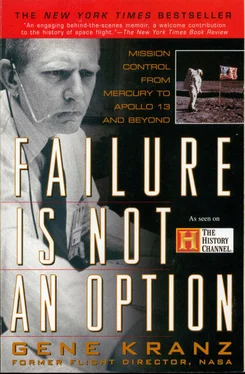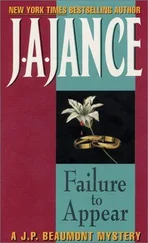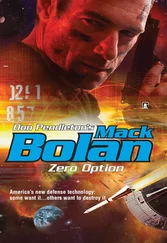Hitting the highway, he made a wide turn and a hard left, burning rubber. In no time, he had the needle quivering between eighty and ninety miles an hour. After a joyful cry of “Eeeee hah,” he turned and offered his hand, saying, “Hi, I’m Gordo Cooper.” I had just met my first Mercury astronaut. As I soon learned, if you saw someone wearing a short-sleeved Ban-Lon sport shirt and aviator sunglasses, you were looking at an astronaut. We humble ground-pounders wore ties and white shirts, and yes, those nerdy pencil-holding pocket protectors.
I thought of that handshake often in the many years that followed. Mercury worked because of the raw courage of a handful of men like Cooper, who sat in heavy metal eggcups jammed on the top of rockets, and trusted those of us on the ground. That trust tied the entire team into a common effort.
I took it as a good omen that Cooper, taking pity on a befuddled stranger, offered me a lift to the base. He was one of the seven former test pilots selected for the first class of astronauts. They had been introduced, unveiled like sculptures, in April of 1959. Instantly the media compared them to Christopher Columbus and Charles Lindbergh. Today, I wonder how many of them the average American could name. They were John Glenn, Alan Shepard, Virgil I. (Gus) Grissom, Wally Schirra, Donald K. (Deke) Slayton, Scott Carpenter, and Cooper. They were similar in size and build, partly because the design of the capsule ruled out anyone over five-foot-eleven.
All of them were white, all from small towns, all middle-class, and all Protestant. This was not the result of deliberate discrimination, but because at the time that was the kind of man who became a military test pilot. At this period it was hard for Americans from any minority to get into flight training. But the military, like the rest of the country, grew up and lived up to its fundamental commitment to equality, thanks in large measure to the civil rights movement that, like the space program in the same era, demanded conviction and courage.
That day when I arrived in Florida I stumbled into the future. I didn’t have enough time even to learn the recently coined space jargon before the Mercury flight director, Chris Kraft, gave me the task of writing the operating procedures for Mercury flight controllers. Without knowing much about anything, I was telling people how to do everything, writing the rules for the control team that would support the Mercury-Redstone launch. Not only had I never laid eyes on the Mercury Control Center, I had never even seen, close up, any rocket big enough to carry a human payload.
I did not really research the program before I joined. I knew that it was called the “man in space project.” Lyndon Johnson, then the Senate majority leader, was given the job by President Dwight Eisenhower of determining how we should respond to the Soviets’ launch of Sputnik on October 4, 1957. The impact of the first orbiting satellite, visible to the naked eye as it passed through the night sky over America, was profound. Sputnik was a shock to national pride— Russian science had put the first object in outer space, giving Americans both an inferiority complex and a heightened sense of vulnerability in what was then the most intense phase of the Cold War. Out of this was born the “missile gap” between ourselves and the Soviet Union.
Years later we would discover that this “gap” was an intelligence myth. But the Soviet Union was indeed ahead in a space race that this tiny, rather primitive satellite had effectively initiated. Our adversary had developed rockets with greater thrust and throw weight—for the military this meant ballistic missiles that could “throw” a heavier warhead a greater distance than anything in our arsenal.
The reverberations of that little sphere emitting its “beep-beep” radio signal as it sailed unrestricted through space were far reaching. Among other things, it would spark a massive federal education funding program, significantly called “The National Defense Education Act,” to stimulate better teaching of math and science as well as foreign languages to more students throughout the country. A sleeping giant suddenly woke up.
One of the other immediate results of Sputnik was the National Space Act of 1958 and the creation of the National Aeronautics and Space Administration. To me, our leap into space was the logical next step beyond the X-15 rocket-powered aircraft. The problem was that our first “leaps” would be some fairly short hops. All of these factors had influenced my decision to join this embryonic program. It had been cautiously funded, was working from a somewhat thin base—and was also a crash effort for everyone involved in it. I don’t think that at the time I realized just how caught up I was in the excitement and challenge of this race. Nor could I have anticipated just how thrilling and dangerous, frustrating and inspiring the first lap in it would be. All of those involved were obsessed by a driving dream, working with an intensity that fused NASA employees and contractors, launch and flight operations into one powerful organism.
Cooper dropped me off at Mercury Control and I was greeted by the familiar face of the only person in the program I knew down at the Cape, Paul Johnson, a troubleshooter working for Western Electric, one of the subcontractors to Bendix in building the control center and the tracking network. Western Electric’s responsibilities included radars, telemetry (radio signals to and from the rocket and spacecraft that told us how things were working—and what wasn’t) control consoles, and communications. These were the core systems. Western Electric quickly parlayed this into a responsibility for integrating operations, training, maintenance, and network communications. Paul was amazingly young for his responsibilities. He had an intuitive feel for this unprecedented development and deployment of technology, writing the specifications and testing procedures and doing everything that needed to be done to check out the largest “test range” in history, one that went around the globe.
“Kraft said you were coming down,” he greeted me, smiling, “and I thought I’d give you a hand.” During the next two days, Johnson gave me a master’s degree in the art of mission control. He had been at the Cape for the preceding week and had been writing the manual on the team structure and operations. He handed it over to me to finish defining the standard operating procedures for Mercury Control, such as how to check out the console displays and communications, set the format for Teletype communications, and how specifically to request data from the technicians (politely but urgently).
I soon began to think of Paul as my guardian angel. From the moment I came on the job it seemed that whatever I was doing, wherever I turned, he was there. He always appeared when the pressure was on and I was happy to see him.
As I felt my way through a program inventing itself, Marta was moving from the motel into a new house in Hampton, Virginia. It was our fifth move in the four years since our marriage, setting up successive households in South Carolina, Texas, Missouri, New Mexico, and now Virginia. Carmen, our two-and-a-half-year-old daughter, had been born in Texas, and Lucy, fourteen months, in New Mexico. Like most service families they were ready for anything, anytime.
The Space Task Group’s launch team was permanently stationed at the Cape to support the test and checkout of the rocket and capsule. The flight team of which I was now a member, the astronauts, engineers, and program office operated from Langley Air Force Base and traveled to the Cape for each mission. I had been on the job in Virginia only two weeks, hardly long enough to figure out the pecking order, when Kraft walked up to my desk and said, “Everyone else is tied up. You’re all I’ve got. We’re coming up on our first Redstone launch. I’d like you to go down to the Cape, get with the test conductors and write a countdown. Then write some mission rules. When you finish give me a call and we’ll come down and start training.”
Читать дальше












